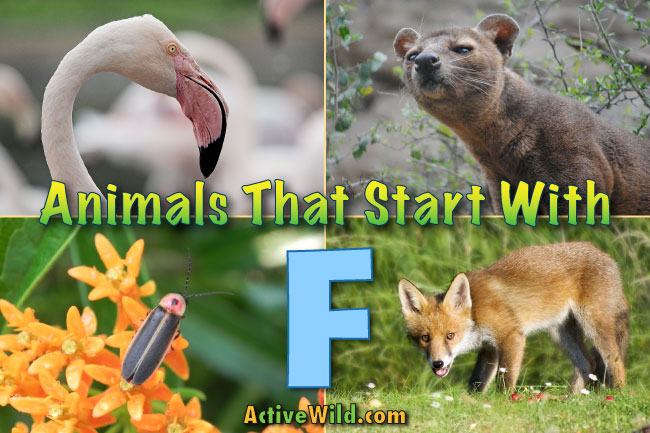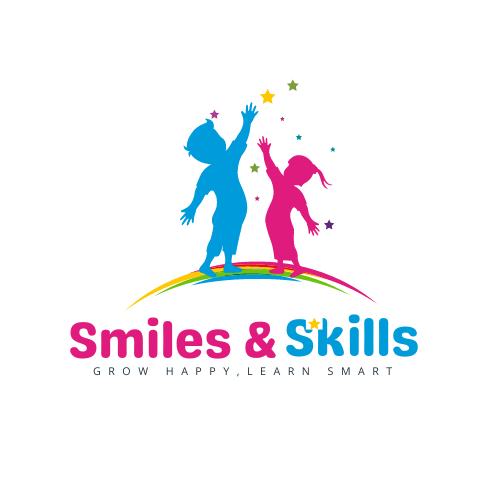Animals that start with F include the flamingo and the fox. These creatures are fascinating and diverse.
Flamingos are known for their striking pink feathers and elegant stance. They inhabit wetlands and feed on algae and small crustaceans. Foxes, on the other hand, are cunning and adaptive mammals found in various habitats around the world. They have keen senses and are skilled hunters.
These animals showcase the diversity and beauty of wildlife. Each species has unique traits and behaviors, contributing to their ecosystems. Learning about animals that start with F can deepen our appreciation for nature and its inhabitants. Both flamingos and foxes play essential roles in their environments, highlighting the importance of wildlife conservation.

Credit: www.activewild.com
Foxes
Foxes are small to medium-sized, omnivorous mammals. They belong to the family Canidae. Foxes are known for their cunning nature and beautiful fur.
Habitat
Foxes are highly adaptable and can live in various habitats. They are found in forests, grasslands, mountains, and deserts. They also thrive in urban areas.
| Habitat Type | Regions |
|---|---|
| Forests | North America, Europe, Asia |
| Grasslands | Africa, Australia |
| Deserts | Sahara, Middle East |
| Urban Areas | Worldwide |
Diet
Foxes have a diverse diet. They are omnivores, eating both plants and animals. Their diet includes:
- Small mammals like rabbits and rodents
- Birds and insects
- Fruits and vegetables
- Fish and amphibians
Foxes are opportunistic feeders. They often scavenge for food in urban areas.
Behavior
Foxes are mostly nocturnal animals. They are active during the night and rest during the day. Foxes are solitary creatures, preferring to live alone. They communicate with each other through vocalizations and scent markings.
Foxes are known for their cunning and intelligence. They use clever tactics to hunt and evade predators. They are also playful and curious animals, often engaging in games and explorations.
Frogs
Frogs are amazing creatures found all over the world. They live in various environments, from forests to deserts. Frogs are known for their jumping ability, croaking sounds, and unique life cycle.
Species Diversity
Frogs come in many species, each unique in its own way. There are over 6,000 species of frogs. Some well-known species include the Tree Frog, Poison Dart Frog, and Bullfrog.
- Tree Frog: Lives in trees, has sticky pads on its feet.
- Poison Dart Frog: Brightly colored, produces toxins, lives in rainforests.
- Bullfrog: Large size, deep croak, lives in ponds and lakes.
Reproduction
Frogs have a fascinating reproduction process. They start as eggs, which hatch into tadpoles. Tadpoles live in water and breathe through gills. They then transform into frogs through a process called metamorphosis.
- Eggs: Laid in water, often in clusters.
- Tadpoles: Hatch from eggs, breathe through gills.
- Metamorphosis: Tadpoles grow legs, lose gills, and become frogs.
Conservation Status
Many frog species are at risk of extinction. Habitat loss, pollution, and climate change are major threats. Conservation efforts are crucial to protect these amazing creatures.
| Species | Conservation Status |
|---|---|
| Tree Frog | Least Concern |
| Poison Dart Frog | Endangered |
| Bullfrog | Least Concern |
Protecting their habitats and reducing pollution can help save frogs. Every effort counts in preserving these amazing animals.
Flamingos
Flamingos are beautiful birds known for their pink feathers and long legs. These birds are often found in large groups near lakes and lagoons. Their unique appearance and behavior make them fascinating creatures to learn about.
Physical Characteristics
Flamingos are famous for their striking pink feathers. This color comes from their diet. They have long, thin legs that allow them to wade in deep water. Flamingos also have a distinctive, curved beak.
Their wings are large and strong, helping them fly long distances. Adult flamingos can stand up to five feet tall. They weigh between four and eight pounds. Their long necks and legs make them easy to spot in the wild.
Feeding Habits
Flamingos feed on algae, small insects, and crustaceans. They use their curved beaks to filter food from the water. Flamingos often feed with their heads upside down. This unique feeding method helps them find food in muddy waters.
They often feed in shallow waters where food is plentiful. Their beaks have special filters to catch small bits of food. This diet gives them their pink color.
Migration Patterns
Flamingos migrate to find food and suitable nesting sites. They travel in large flocks to stay safe. During migration, flamingos can fly long distances. They often fly at night to avoid predators.
Flamingos prefer warm climates and migrate to stay in suitable temperatures. Their migration patterns depend on food availability and weather conditions. Flamingos usually return to the same nesting sites each year.
Falcons
Falcons are remarkable birds of prey known for their swift flight and keen hunting skills. They belong to the Falconidae family and are found all over the world. Falcons are admired for their agility and sharp vision, making them efficient hunters.
Hunting Techniques
Falcons use several hunting techniques to catch their prey. They often hunt in the air, diving at incredible speeds to strike their target. This technique, known as a stoop, is highly effective.
These birds also use surprise and ambush methods. They hide and wait for the right moment to attack. Falcons have sharp talons and beaks to capture and kill their prey quickly.
They primarily hunt small birds, but some species also eat insects and rodents. Their diet varies based on their habitat and availability of prey.
Breeding
Falcons are monogamous and often mate for life. The breeding season varies by species and location. They usually build nests on high cliffs or tall trees to keep their eggs safe.
The female lays 2-5 eggs, and both parents take turns incubating them. The incubation period lasts around 30 days. Once hatched, the chicks are fed by both parents until they are ready to fledge.
Young falcons learn to hunt by observing their parents. They stay with their parents for several months before becoming independent.
Distribution
Falcons are found on every continent except Antarctica. They inhabit a wide range of environments, from forests to deserts. Some species are migratory, traveling long distances between breeding and wintering grounds.
The Peregrine Falcon is the most widespread falcon species. It can be found in urban areas as well as wild habitats. Other species have more specific ranges, often limited to certain regions or climates.
The distribution of falcons is influenced by the availability of food and suitable nesting sites. Conservation efforts are crucial for protecting these magnificent birds and their habitats.
Ferrets
Ferrets are small, playful animals with long, slender bodies. They belong to the mustelid family, which includes weasels, otters, and badgers. Ferrets are known for their curiosity and energetic nature. They can make wonderful pets with proper care.
Domestication
Ferrets have been domesticated for over 2,000 years. Ancient civilizations used ferrets for hunting rabbits and controlling pests. Today, ferrets are popular pets worldwide. They have been bred for their friendly and playful nature.
Natural Habitat
Wild ferrets, like the European polecat, live in forests and grasslands. They make burrows or use abandoned animal dens for shelter. Domesticated ferrets do not have a natural habitat. They depend on humans for food, shelter, and care.
Health And Care
Ferrets need proper care to stay healthy and happy. Here are some important aspects:
- Diet: Ferrets are carnivores and need a diet high in protein and fat. Provide them with high-quality ferret food or specialized cat food.
- Exercise: Ferrets are active animals. They need at least 2-4 hours of playtime outside their cage daily.
- Vaccinations: Regular vaccinations are essential to protect ferrets from diseases. Consult a veterinarian for a vaccination schedule.
- Grooming: Ferrets have a natural musky odor. Regular bathing and ear cleaning can help manage this. Trim their nails every few weeks.
- Health Checkups: Regular vet checkups are important to detect and treat health issues early. Watch for signs of illness like lethargy or loss of appetite.
Providing a safe and stimulating environment is crucial. Ferrets are curious and can get into trouble easily. Ensure their living space is ferret-proofed to prevent accidents.
| Aspect | Details |
|---|---|
| Diet | High in protein and fat |
| Exercise | 2-4 hours of playtime |
| Vaccinations | Regular vet schedule |
| Grooming | Bathing, ear cleaning, nail trimming |
| Health Checkups | Regular vet visits |

Credit: www.firstcry.com
Fireflies
Fireflies are fascinating insects known for their glowing lights. These tiny creatures captivate us with their magical bioluminescence. Many people love watching fireflies light up summer nights. Let’s dive into the world of fireflies and learn more about them.
Bioluminescence
Fireflies produce light through a process called bioluminescence. They have special organs in their abdomen. These organs mix chemicals to create light. The light is usually yellow, green, or pale red. Fireflies use this light to attract mates. This glow is also a warning to predators. “Stay away, I taste bad!”
| Chemical | Role |
|---|---|
| Luciferin | Produces light when mixed with oxygen |
| Luciferase | Enzyme that speeds up the reaction |
| ATP | Provides energy for the reaction |
Life Cycle
Fireflies go through four life stages: egg, larva, pupa, and adult.
- Egg: Female fireflies lay eggs in the soil.
- Larva: Eggs hatch into larvae. Larvae are often called “glow worms.”
- Pupa: Larvae turn into pupae. They stay in this stage for a few weeks.
- Adult: Pupae emerge as adult fireflies. Adults live for about 2 months.
Ecological Importance
Fireflies play a crucial role in the ecosystem. They help control pest populations. Larvae eat slugs, snails, and other small creatures. This keeps gardens and crops healthy. Fireflies are also important pollinators. They help plants reproduce by spreading pollen.
Fireflies are indicators of a healthy environment. Their presence shows clean air and water. Protecting firefly habitats helps protect nature.
Fireflies are more than just pretty lights. They are vital to our world.
Fennec Foxes
Fennec foxes are small, nocturnal animals native to the Sahara Desert. They are known for their large ears and playful nature. These foxes are the smallest of all the world’s foxes. Their unique features help them survive in the harsh desert environment.
Adaptations
Fennec foxes have several adaptations that help them thrive in the desert. Their large ears not only provide excellent hearing but also help with heat dissipation. This is crucial in the hot desert climate.
Their fur is thick and sandy-colored, which provides camouflage and protects them from the sun. They have fur on the soles of their feet to protect against the hot sand.
Fennec foxes are nocturnal, which helps them avoid the intense daytime heat. They dig burrows to live in, which offer a cool retreat during the day.
Social Structure
Fennec foxes have a unique social structure. They live in small family groups, usually consisting of a male, a female, and their offspring. These groups are known to cooperate in raising the young.
Within the family group, there is a clear hierarchy. The male is often the dominant figure, but the female also plays a crucial role. They are monogamous, meaning they mate for life.
Communication among fennec foxes includes a variety of vocalizations, body language, and scent markings. This helps them maintain social bonds and defend their territory.
Threats
Fennec foxes face several threats in the wild. One of the main threats is habitat loss due to human activities like mining and agriculture. This reduces the available space for them to live and hunt.
They are also hunted for their fur and captured for the illegal pet trade. These activities significantly impact their population numbers.
Climate change poses another threat by altering their desert habitat. Changes in temperature and rainfall patterns can affect their food sources and living conditions.
Overall, fennec foxes are fascinating creatures with unique adaptations and social structures. Protecting them is essential for maintaining the biodiversity of the desert ecosystem.
Flying Squirrels
Flying squirrels are fascinating nocturnal creatures known for their gliding abilities. These small mammals belong to the family Sciuridae and can be found in various parts of the world. They are not true fliers but use a unique gliding mechanism to move between trees.
Gliding Mechanism
Flying squirrels have a special membrane called the patagium. This membrane stretches from their wrists to their ankles. When they leap from a tree, they spread their limbs to glide. The patagium acts like a parachute, allowing them to glide through the air. They can glide up to 150 feet in a single leap. This helps them escape predators and find food.
Nocturnal Behavior
Flying squirrels are nocturnal, meaning they are active at night. They have large eyes that help them see in the dark. They use their keen senses to find food and avoid danger. They are very social animals and often share nests with other squirrels. At night, you can hear their chirps and squeaks as they communicate.
Habitat
Flying squirrels live in forests, especially those with tall trees. They build their nests in tree cavities or use abandoned bird nests. They prefer dense forests that provide cover from predators. They can also be found in suburban areas with plenty of trees. Their diet includes nuts, seeds, fruits, and insects. They store food in their nests to eat during the winter.

Credit: www.pinterest.com
Alphabet Table: Animals Starting With A-Z
Frequently Asked Questions
What Animal Starts With An F?
A popular animal that starts with an F is the fox. Foxes are small, omnivorous mammals found worldwide.
What Are The 5 F Animals?
Five animals that start with the letter F are fox, frog, falcon, flamingo, and ferret.
What Sea Animals Start With F?
Sea animals that start with F include the Flying Fish, Fin Whale, and Fiddler Crab. These fascinating creatures inhabit various ocean regions, showcasing unique adaptations. The Flying Fish glides above water, Fin Whales are massive baleen whales, and Fiddler Crabs are known for their distinctively large claws.
What Is The Name Of The Australian Animal That Starts With F?
The Australian animal that starts with “F” is the Feathertail Glider. This tiny marsupial is known for its gliding ability and feathery tail. It is native to eastern Australia and inhabits forests and woodlands.
Conclusion
Exploring animals that start with F has been fascinating. From foxes to flamingos, each creature is unique. These animals play vital roles in their ecosystems. Learning about them enhances our appreciation for nature. Keep discovering and sharing knowledge about these wonderful animals.
Your curiosity contributes to wildlife conservation and education.

